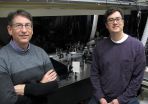(Press-News.org) Scientists and engineers have built a computer model that has uncovered disease-causing mutations in large regions of the genome that previously could not be explored. Their method seeks out mutations that cause changes in 'gene splicing,' and has revealed unexpected genetic determinants of autism, colon cancer and spinal muscular atrophy.
CIFAR Senior Fellow Brendan Frey (University of Toronto) is the lead author on a paper describing this work, which appears in the Dec. 18 edition of Science Express. The paper was co-authored by CIFAR senior fellows Timothy Hughes (University of Toronto) and Stephen Scherer (The Hospital for Sick Children and the University of Toronto) of the Genetic Networks program. Frey is appointed to the Genetic Networks program, and the Neural Computation & Adaptive Perception program. The research combines the latter groups' pioneering work on deep learning with novel techniques in genetics.
Most existing methods examine mutations in segments of DNA that encode protein, what Frey refers to as low-hanging fruit. To find mutations outside of those segments, typical approaches such as genome wide association studies take disease data and compare the mutations of sick patients to those of healthy patients, seeking out patterns. Frey compares that approach to lining up all the books your child likes to read and looking for whether a particular letter occurs more frequently than in other books.
"It doesn't work, because it doesn't tell you why your kid likes the book," he says. "Similarly, genome-wide association studies can't tell you why a mutation is problematic."
But looking at splicing can. Splicing is important for the vast majority of genes in the human body. When mutations alter splicing, genes may produce no protein, the wrong one or some other problem, which could lead to disease.
Frey's team, which includes researchers from engineering, biology and medicine, developed a computer model that mimics how the cell directs splicing by detecting patterns within DNA sequences, called the 'splicing code'. They then used their system to examine mutated DNA sequences and determine what effects the mutations would have, effectively scoring each mutation. Unlike existing methods, their technique provides an explanation for the effect of a mutation and it can be used to find mutations outside of segments that code for protein.
To develop the computer model, Frey's team fed experimental data into machine learning algorithms, so as to teach the computer how to examine a DNA sequence and output the splicing pattern.
Their method works surprisingly well and has led to new discoveries. For example, using DNA sequences from five patients with autism provided by Scherer, the model was able to identify 39 new genes that could be implicated in autism spectrum disorder, a 40 per cent increase from about 100 previously known autism genes.
"Brendan's work is groundbreaking because it represents a first serious attempt to decode the portions of that 98 per cent of the human genome outside the genes that are typically studied in genetic disease studies," Scherer says. "This is particularly exciting since it is thought these segments of DNA may contain much of the missing information that we have been looking for in studies like autism."
Scherer and Frey began collaborating at CIFAR meetings five years ago and they intend to use this model to analyze the genomes of 10,000 families with autism as part of the MSSNG study. The paper also sheds light on the genetic mechanisms that lead to spinal muscular atrophy, a leading cause of infant death, and nonpolyposis colorectal cancer.
Frey says his involvement in two CIFAR programs was crucial in making connections and in developing interdisciplinary expertise among his graduate students and postdoctoral fellows, including co-authors Hui Xiong, Babak Alipanahi, Leo Lee and Hannes Bretschneider. Also involved were Ben Blencowe of the University of Toronto and Nebojsa Jojic of Microsoft Research.
"My participation in the Neural Computation & Adaptive Perception program enabled my group to have access to the best techniques in deep learning," Frey says. He adds that his interactions with members of the Genetic Networks program challenged him to take on some of the toughest questions in genetics.
CIFAR Senior Fellow Frederick Roth, co-director of the program in Genetic Networks, says Drs. Frey, Scherer and Hughes have been key members of the program and its efforts to interpret the genome. "Many of us will soon know our complete human genome sequence, which will be like having an encyclopedic guide to ourselves that is written in an alien language. This work promises to interpret the impact of mutations in a broader region of our genome than has been previously possible," he says.
INFORMATION:
About CIFAR
CIFAR creates knowledge that will transform our world. The Institute brings together outstanding researchers to work in global networks that address some of the most important questions our world faces today. Our networks help support the growth of research leaders and are catalysts for change in business, government and society.
Established in 1982, CIFAR is a Canadian-based, global organization, comprised of nearly 350 fellows, scholars and advisors from more than 100 institutions in 16 countries. CIFAR partners with the Government of Canada, provincial governments, individuals, foundations, corporations and research institutions to extend our impact in the world.
Alternate Contact
Brendan Frey
CIFAR Senior Fellow
University of Toronto
frey@psi.toronto.edu
(647) 234-0429
The evolution of trichromatic color vision in humans occurred by first switching from the ability to detect UV light to blue light (between 80-30 MYA) and then by adding green-sensitivity (between 45-30 MYA) to the preexisting red-sensitivity in the vertebrate ancestor. The detailed molecular and functional changes of the human color vision have been revealed by Shozo Yokoyama et al. Emory University and is published in the journal PLOS Genetics.
The molecular basis of functional differentiation is a fundamental question in biology. To fully appreciate how these changes ...
CAMBRIDGE, MA -- For decades, neuroscientists have been trying to design computer networks that can mimic visual skills such as recognizing objects, which the human brain does very accurately and quickly.
Until now, no computer model has been able to match the primate brain at visual object recognition during a brief glance. However, a new study from MIT neuroscientists has found that one of the latest generation of these so-called "deep neural networks" matches the primate brain.
Because these networks are based on neuroscientists' current understanding of how the ...
A University of Southampton researcher has helped solve a long standing space mystery - the origin of the 'theta aurora'.
Auroras are the most visible manifestation of the Sun's effect on Earth. They are seen as colourful displays in the night sky, known as the Northern or Southern Lights. They are caused by the solar wind, a stream of plasma - electrically charged atomic particles - carrying its own magnetic field, interacting with the earth's magnetic field.
Normally, the main region for this impressive display is the 'auroral oval', which lies at around 65-70 degrees ...
PROVIDENCE, R.I. - Where you live affects the type of bacteria that cause bloodstream infections, according to researchers at Rhode Island Hospital and an international team of investigators. The closer you live to the equator, the greater the likelihood of a bloodstream infection caused by a group of bacteria called Gram-negative bacteria, which thrive in warm and moist environments, compared to another group of bacteria referred to as Gram-positive bacteria. The study also found that the proportion of a country's GDP spent on health care impacted the type of bacteria ...
DALLAS - Dec. 18, 2014 - Retroviruses are best known for causing contagious scourges such as AIDS, or more sporadically, cancer.
But researchers at UT Southwestern Medical Center and Karolinska Institutet in Stockholm, Sweden, found that endogenous retroviruses (ERV) also play a critical role in the body's immune defense against common bacterial and viral pathogens.
"Most scientists have become used to the view that retroviruses are generally harmful," said Nobel Laureate Dr. Bruce Beutler, Professor and Director of UT Southwestern's Center for the Genetics of Host ...
Primates visually recognise and determine the category of an object even at a brief glance, and to date, this behaviour has been unmatched by artificial systems. A study publishing this week in PLOS Computational Biology has found that the latest artificial "deep neural network" performs as well as the primate brain at object recognition.
Charles Cadieu and colleagues from MIT measured the brain's object recognition ability by implanting arrays of electrodes in the inferior temporal cortex of macaques. This allowed the researchers to see the neural representation -- the ...
A definitive geological timeline shows that a series of massive volcanic explosions 66 million years ago spewed enormous amounts of climate-altering gases into the atmosphere immediately before and during the extinction event that claimed Earth's non-avian dinosaurs, according to new research from Princeton University.
A primeval volcanic range in western India known as the Deccan Traps, which were once three times larger than France, began its main phase of eruptions roughly 250,000 years before the Cretaceous-Paleogene, or K-Pg, extinction event, the researchers report ...
(Boston)--Dr. Deborah Anderson from Boston University School of Medicine (BUSM) and her colleagues are challenging dogma about the transmission of the human immunodeficiency virus type 1 (HIV-1). Most research has focused on infection by free viral particles, while this group proposes that HIV is also transmitted by infected cells. While inside cells, HIV is protected from antibodies and other antiviral factors, and cell-to-cell virus transmission occurs very efficiently through intercellular synapses. The Journal of Infectious Diseases (JID) has devoted their December ...
EUGENE, Ore. -- Dec. 18, 2014 -- Four pulses of laser light on nanoparticle photocells in a University of Oregon spectroscopy experiment has opened a window on how captured sunlight can be converted into electricity.
The work, which potentially could inspire devices with improved efficiency in solar energy conversion, was performed on photocells that used lead-sulfide quantum dots as photoactive semiconductor material. The research is detailed in a paper placed online by the journal Nature Communications.
In the process studied, each single photon, or particle of ...
Washington, DC--As people in developing nations relocate from rural areas to cities, the increased stress is affecting their hormone levels and making them more susceptible to diabetes and other metabolic disorders, according to a new study published in the Endocrine Society's Journal of Clinical Endocrinology & Metabolism (JCEM).
About 387 million people worldwide have diabetes, and 77 percent of them live in low- and middle-income countries, according to the International Diabetes Federation. In the Middle East and north Africa, one in 10 adults has diabetes.
One ...


